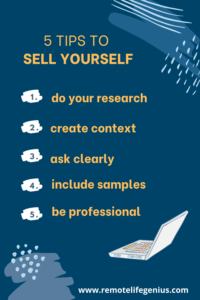 As a freelancer, the success of your business relies heavily on learning how to sell yourself. So, whether or not you have a strong network of potential clients, you need to master the pitch.
As a freelancer, the success of your business relies heavily on learning how to sell yourself. So, whether or not you have a strong network of potential clients, you need to master the pitch.
You need to know how to pitch new clients and make your value clear online, over the phone, and even in-person.
Anyone can reply to an Upwork project or other job board, but not every freelancer can pitch effectively.
In fact, the freelancers making the most in their field have all learned how to pitch themselves and their services well.
Page Contents
What’s in a pitch?
In summary, your pitch is the tool you use anytime you reach out to a potential client. This includes reaching out for new business, contacting a former colleague, and even asking existing clients for another project.
Ineffective pitches result in an inbox full of rejection letters. But well-crafted pitches result in more gigs and higher-paying jobs.
So, what’s in an amazing pitch? And how do you perfect yours?
Preparation – Start with an Ideal Client
If you are pitching a specific idea, you must do your homework. Effective pitches take a bit of research and thinking about your potential clients’ business. However, you have limited time in your day and you want to spend it wisely.
So, before you go researching every company listing projects on Upwork, take the time to define your ideal client.
 When you have an intentionally defined type of client, your research efforts are going to be more focused. This will save you time in the long-run and increase your chances of writing an effective pitch.
When you have an intentionally defined type of client, your research efforts are going to be more focused. This will save you time in the long-run and increase your chances of writing an effective pitch.
Figure out if your ideal clients are:
- Companies or individuals
- Small businesses or large corporations
- Tech-savvy or tech-slow
- In a certain industry
- In a certain location
Once you’ve narrowed it down, then you can craft a list of 10-20 potential clients you want to pitch.
5 Elements of Amazing Pitches
1. Client’s Needs Up Front
Yes, your pitch will have to talk about yourself. But, the best pitch starts with the client’s needs. Your goal is to resonate with your potential client. This is why you need to research.
Ask yourself:
- What are their biggest pain points?
- What goals do they have right now?
- How can my work impact their day/time/social presence/brand/sales funnel?
- What metrics can I tie my services to
You want your potential client to read your pitch and think “Yes! That’s exactly what I need.” or “Yes, this person gets me, I can see myself working with them.”
In order to do so, you have to prove that you understand their business enough to know how your services will impact them.
Providing this context also helps develop a sense of rapport. If you’re able to, you can start with a genuine compliment. Check their most recent news and updates. Find something to establish a common ground and then prove you know their business.

With this in mind, as someone who has hired dozens of freelancers, I will let you know that it’s very obvious when someone pitching a service is only thinking about themselves. Their pitches are often a variation of:
“Your job post was interesting to me, I’d like to learn more. How much does it pay?” or “I saw your job posting, and I’m interested. Can you send more information?”
The first pitch is clearly from an individual who only cares about the transaction, the money. And, in my experience, these individuals are more likely to deliver subpar work and complain later on.
There’s nothing wrong with asking for payment information, but make sure that you’ve established other reasons why you’re interested in the client and project.
The error in the second email is that it asks the client to do more work. As a freelancer, you need to come in and show that you can solve a problem, add value, or make your client’s life easier.
Additionally, if you want more information, provide relevant information about yourself first. Give your leads the context they need, and when you ask questions, make them specific. All of this combined demonstrates that your interest in the job is serious.
2. A Context for your Services
As mentioned before, a good pitch includes a clear statement of what it is you have to offer. However, there are good ways to do this, and great ways to do this.
The difference between mediocre pitches and pitches that land gigs is providing the correct context. Make it easy for them to view your services in the context of their business.
When you introduce your services or a specific idea, make sure to connect your offer to a positive end-result.
Here are a few examples:
- Landing pages that convert more and increase sales
- White papers that generate more leads
- Logo and design elements that elevate your brand
- A fast website that decreases your bounce rate
By demonstrating that you understand the end result of your work, you can rise above the competition. Remember, you can go ahead and submit good pitches. But if your competition is out there submitting amazing pitches, your chances will still be slim.
The way that you introduce yourself should also be in context. Your role/title should match what the company is looking for. Additionally, make sure to specify your niche and mention awards/certifications that are relevant.
3. The Straightforward Ask
Excellent pitches are well-researched, straight to the point, and clear. Never leave a potential client wondering what you’re asking them.
If you are responding to a job posting, it’s as simple as mentioning the post and saying “I would like to apply.”
On the other hand, if you are cold-pitching might ask for an introductory call. Something along the lines of, “I’d like to schedule a call to discuss how my services can help X company increase sales.”
And finally, for the repeat sale, you can specify the project type. In this circumstance, it might be appropriate to provide an outline of what you want to provide. This is recommended if you were able to gain a good understanding of their business on your previous work.
For example, let’s say that you were a freelance digital marketer running Facebook posts for a company. Your ask for repeat business could look like, “I know that you’re looking at Instagram strategies to increase your brand awareness. I can run preliminary Instagram A/B tests for you to determine the best post types and then create and schedule your weekly posts on the platform. Would you like me to send over a proposed project timeline we can discuss?”
See the difference? The above example had
- a clear benefit (increase brand awareness)
- details about the service (A/B testing content for Instagram and then running social posts)
- straightforward ask (send over a proposed project timeline to discuss)
This step may take some time to get used to. As a freelancer, you want to avoid seeming too aggressive or overly confident. However, if you take it too far and end up writing proposals that lack confidence and clarity, you’re not helping your client get to know you.
Treat your potential clients time as if it’s valuable. Don’t add extra paragraphs or fluff to soften your ask. If you’re confident that you can create value, it’s easier for your clients to have confidence in you.
4. Proof Points
All good pitches should have easy access to relevant samples or other proof of value. Taking the time to select 2-3 of the most relevant portfolio items will make a difference.
While it can be easier to share your entire website or portfolio, think about it this way. Do you really trust a cold lead to click through and then select the best example out of all your work?
Maybe they do, but it’s a big risk to take. So, make it easy for them to see you in the best light.
 Even if you don’t have that many to choose from, listing a couple of samples instead of your entire portfolio gives the illusion that you took the time to select them.
Even if you don’t have that many to choose from, listing a couple of samples instead of your entire portfolio gives the illusion that you took the time to select them.
Now, if you’re still inexperienced as a freelancer or don’t have samples that are perfectly relevant to a pitch, it helps to include your Linkedin or CV. Even if you have these links in your email signature, mentioning it in the body of your pitch encourages your potential client to click through.
By having items for your client to click through, you’re giving them the opportunity to invest a little time getting to know you. And, once someone has invested time or action in you, their perception of your value increases.
Even though it’s important to include work samples, you can go overboard here. Limit yourself to 3 work samples and 1 resume OR Linkedin link. You don’t want to overwhelm your prospect with an encyclopedia of everything you’ve done.
And, of course, make sure the samples and links you include are truly your best work. This should go without saying, but do not link to a resume or Linkedin that you haven’t updated in 3 years.
5. Always Professional
As a creative worker, you don’t always have to adhere to a business formal style of writing. In fact, adding some creativity and personality can be a great way to set yourself apart.
However, there is a difference between personality and unprofessionalism. Proofread everything before sending it. Especially if this is your first impression.
Grammar mistakes and misspelling tell your client that you don’t care about your pitch and you don’t check your work. And guess what? That’s not who they want to hire.
If you’re a freelance writer, poorly written emails are a fast lane to an inbox full of rejection letters. In contrast, other types of freelancers don’t need to be exceptional writers, but you must still communicate effectively.
Communication is a key part of working with your clients, so always make sure that you’re clear and professional.
At Remote Life Genius, we recommend Grammarly to anyone using written communication as part of their business. They have a free chrome extension that will automatically check your emails and documents for errors.
If you want, you can upgrade to a premium plan that will suggest stronger word choice and grade your emails based on tone.
How to Successfully Support Your Pitch
Pitching clients is only one part of your lead generation and sales strategy. And, in the age of the internet, even the most excellent of pitches won’t be enough to seal the deal.
An amazing pitch opens up an opportunity for you by capturing your prospects’ interest. After that, a prospect will likely do a little background on you. So, here are the things you need to do to pass the “deeper look” phase of the test.
Proofread your samples
Now, this is part of the pitch, but it’s important enough to mention here. Your samples should be
- relevant
- easy to access
- indicative of your best work
Click through your own links and make sure that any files are accessible and all of your web sample links are still active. Don’t make a prospective client jump through hoops. Remember, you want to demonstrate that you can make their life better and/or easier.
Move your profile/portfolio to its own website
 Investing in creating your own website makes you appear professional and keeps your clients focused on YOU.
Investing in creating your own website makes you appear professional and keeps your clients focused on YOU.
Let’s look at this through contrast. Let’s say instead of creating your own website, you have an Upwork profile with all your experience, your best samples, and great reviews from past clients. There’s one main problem, Upwork was built to help clients find ANY freelancer, not just you.
Even if your client loves your profile, now they have to figure out the best way to contact you. Is it through Upwork? Do they respond to your email?
So, sending a potential client to a site with access to your competition is distracting at best and risky worst.
On the contrary, if you provide a link to your website, everything is focused on your services and strengths. You appear more legitimate because you have a site dedicated fully to you. And, your site can provide crystal clear instructions on the next steps to hiring you.
Get active on social media
![]() Oftentimes clients will do a quick Google or Social Media search on you. In the end, there is a person on the other end of that email thread. It’s that person who will be making the decision on whether or not to hire you.
Oftentimes clients will do a quick Google or Social Media search on you. In the end, there is a person on the other end of that email thread. It’s that person who will be making the decision on whether or not to hire you.
And the truth is, we tend to work with people that we know, like, and trust. So, if you haven’t worked with this client before, they’re going to want to get to know you a little bit. What easier way to do that than social media?
When a client finds your social media, what do you want them to see?
Here are some tips to make your social media presence work for you.
- Include your profession in your bio (you can also include your top values)
- Showcase your personality
- Show that you’re passionate about your work
- If you have a niche, your interests show up in your social media
- Search for and remove red flags (inappropriate language, hate speech, complaining about past clients publicly, complaining about your work publicly)
- Include awards and certifications in your bio
As an independent and creative worker, you don’t have to separate your “work self” from your “personal self”. If you’re doing work you love, it all comes together. An active presence on social media shows that you care about what you do, and you’re staying active on new findings and trends in your profession.
Your social media presence is part of your overall personal brand. It helps solidify your professional identity, and it can help you expand your network and find new opportunities.
You don’t need to be super active on all platforms. Include the ones that showcase you best in your email signature.
And, for your own sake, Google yourself to make sure there are no red flags or distractions in the results.
Network & Find Guest Posting Opportunities
Passionate people are active people. They interact with thought leaders in their professional space.
In addition to cold pitching and social media, guest posting is a terrific way to establish yourself, and it’s not just for freelance writers. Whatever your passion is, there are others who share it. And where there are passionate people, there’s content. It can be blogs, magazines, podcasts, or radio shows to name a few.
Reach out to a few of the publications and ask for opportunities to contribute to the conversation. Maybe this is doing an interview on a podcast, or maybe it’s sharing your personal work process as a photographer.
Either way, guest posting can expand your network, help other people find you, and show prospects that you’re established and respected in your field.
Conclusion
Pitching is an essential part of the freelance business. Learning how to pitch well will take you from feeling desperate to be hired to confident and sure of your value. You’ll stop being focused on each individual transaction and start building a profitable network when you present yourself the right way.
Amazing pitches do a few things well
- Demonstrate that you understand your client
- Introduce your services in the best context
- Link to relevant and high-quality samples (build trust)
- Make a clear ask
- Make it easy for the client at all steps of the way
All in all, sales are the powerhouse behind a business. As a freelancer, your success depends heavily on your ability to sell yourself and your services. It takes some time, and some trial and error, but learning to create excellent pitches on demand will have a direct impact on your bottom line.
Want to learn more about creating a personal brand? Discover the top 5 mistakes people make with personal brands and how to avoid them here.
Enjoyed the read? Pin the article to save for later!



